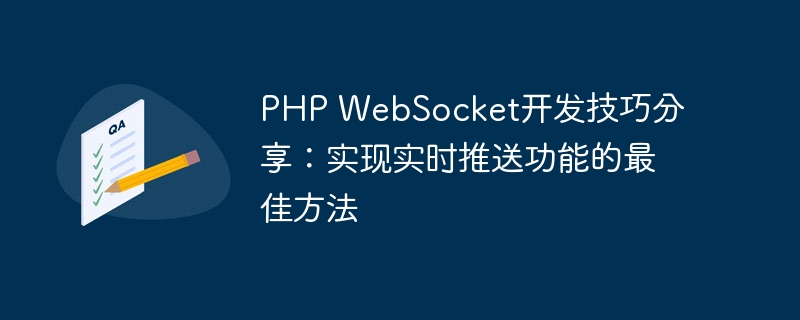Home >Backend Development >PHP Tutorial >PHP WebSocket development skills sharing: the best way to implement real-time push function
PHP WebSocket development skills sharing: the best way to implement real-time push function
- WBOYWBOYWBOYWBOYWBOYWBOYWBOYWBOYWBOYWBOYWBOYWBOYWBOriginal
- 2023-09-12 12:09:181059browse

PHP WebSocket development skills sharing: The best way to implement real-time push function
In modern website development, real-time push function has become an increasingly important needs. PHP WebSocket is a powerful tool that can easily implement real-time push functionality. This article will share some PHP WebSocket development tips to help developers achieve the best real-time push function.
1. Understand the basics of WebSocket
WebSocket is a TCP-based protocol that allows the establishment of a persistent connection between the client and the server to achieve real-time two-way data transmission. Compared with traditional HTTP requests, WebSocket can greatly reduce the burden on the server and achieve true real-time communication. Therefore, developers need to have a good understanding of the basics of WebSocket before starting development.
2. Choose the appropriate WebSocket library
In PHP, there are many mature WebSocket libraries to choose from, such as Ratchet, Swoole, etc. Different libraries have different characteristics and applicable scenarios. Developers should choose the most suitable WebSocket library based on project needs.
3. Establish a WebSocket service
Using the selected WebSocket library, developers need to establish a WebSocket service to establish a connection with the client. The WebSocket service is usually an independent process or daemon that listens to a specified port and waits for client connection requests.
4. Handling WebSocket connections
Once the client establishes a connection with the WebSocket service, developers need to write code to handle the connection. This includes accepting and processing messages sent by the client and sending appropriate messages to the client.
5. Implement the real-time push function
The core of the real-time push function is that the server actively sends messages to the client. In WebSocket, the server can send messages to the client at any time without waiting for the client's request. Developers can implement different real-time push functions based on project needs, such as chat systems, notification reminders, etc.
6. Handling connection disconnection
In WebSocket, connection disconnection is a common situation. Developers should handle disconnections in their code and clean up resources in a timely manner. This includes removing broken connections from the connection list, releasing occupied resources, etc.
7. Consider scalability
When developing WebSocket applications, it is very important to consider the scalability of the application. Developers should take care to design a good architecture so that new server nodes can be easily added when server capacity needs to be expanded.
Conclusion
By understanding the basics of WebSocket, choosing an appropriate WebSocket library, establishing a WebSocket service, handling connections and implementing real-time push functions, developers can easily implement real-time push functions. I hope that the PHP WebSocket development skills shared in this article can help readers better cope with the needs of real-time push functions and improve development efficiency and user experience.
The above is the detailed content of PHP WebSocket development skills sharing: the best way to implement real-time push function. For more information, please follow other related articles on the PHP Chinese website!

